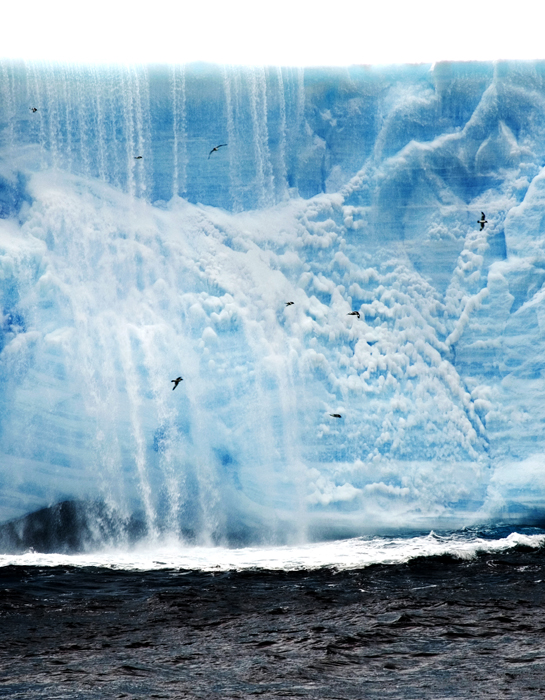|
The hotspotIcebergs become source of nutrients for biological communities as they meltPosted May 16, 2008
In 2005, scientists aboard the ARSV Laurence M. Gould went on what pelagic biologist Bruce Robison said some in the scientific community characterized as a quixotic quest to prove icebergs are a hotspot for life in the deep ocean. The team of geochemists, oceanographers, biologists and others indeed found a host of animals and organisms above, below and on the icebergs, including seabirds, phytoplankton and shrimp-like krill. But they also believe these floating chunks of ice may play a significant role in removing carbon dioxide from the atmosphere thanks to the associated biological community. The research culminated with the publication of the team’s paper in the journal “Science” last year. Now many of the same members of that group are returning to the Weddell Sea at the end of May for a one-month science cruise aboard the RVIB Nathaniel B. Palmer to further study how icebergs affect the marine ecosystem. A second cruise is planned for March 2009. So how can a block of ice, even one as big as Manhattan Island, give birth to a diverse biological community, one that can extend as much as 4 kilometers from the iceberg? It turns out these icebergs, made of glacial ice that once ground against bedrock, hold terrestrial materials that contain traces of micronutrients including iron, which it drops like breadcrumbs into the sea as it melts. Iron helps create blooms of phytoplankton, mostly composed of algae, which absorb carbon dioxide (CO2) from the atmosphere. Some of that carbon will return to the atmosphere, but much of it will sink into the deep ocean, when the algae die, removing carbon from the system for hundreds if not thousands of years. CO2 is a key greenhouse gas. “We’re trying to look at how much organic carbon is basically produced by the phytoplankton and how much escapes into the deep ocean,” explained oceanographer Ken Smith, the project’s principal investigator from California-based Monterey Bay Aquarium Research Institute (MBARI). The researchers also want to determine how much iron the icebergs deposit in the ocean as they migrate, as well as how the micronutrient promotes phytoplankton growth and photosynthesis. A well-known theory called the Iron Hypothesis, put forward by oceanographer John Martin in the 1980s, says that some areas of the oceans contain the major nutrients required for aquatic plant growth — nitrate and phosphate. What’s lacking are the micronutrients like iron. Scientists call these areas of the ocean, including the Southern Ocean, high nutrient low chlorophyll regions. One save-the-planet theory, put forward by Martin and others, suggests seeding the ocean with iron to increase phytoplankton blooms, which would soak in more CO2, presumably lowering the amount of the greenhouse gas in the atmosphere and subsequently lowering temperatures. It’s sort of like adding Miracle Grow® to your garden to improve plant growth. Timothy Shaw, a geochemist from the University of South Carolina, said it appears the icebergs can provide iron and other micronutrients from the terrestrial material they carry. On the 2005 cruise, he and his group measured isotopes of radium, including radium 224, that they collected from the seawater around two icebergs. Radium is ubiquitous in terrestrial material, he explained, so the scientists used it as a proxy for determining the presence of iron and other micronutrients like zinc, which would also be present in terrestrial material. The radioisotope radium 224 has a half-life of 3.6 days, Shaw said. “So, if we could measure it around icebergs, we were sure that it wasn’t a long-distance source,” he said. “The half-life is so short that you can’t have it transported long distances from continents.” The half-life is the amount of time it takes for half of the atoms in a sample to decay. The icebergs become an intermediary between the terrestrial and ocean systems, what Shaw called a Lagrangian estuary, a moving source of biological diversity. “This kind of fits the model of a moving estuary,” said Shaw, a co-principal investigator on the project. On the two trips to the Weddell Sea, Shaw and his group will “map the inventories of particulate material, radioisotopes and iron to validate our contention that icebergs deliver a tremendous amount of terrestrial material.” To make that and other determinations about iceberg characteristics, the researchers will use a number of tools, including a device developed by Scripps Institution of Oceanography called a SOLO float. The SOLO float, which stands for Sounding Oceanographic Lagrangian Observer, can dive up to 2 kilometers deep in the upper ocean, taking temperature, depth and salinity readings as it moves up and down in the water based on a set of instructions encoded in its electronics package. Thousands of these floats have been deployed in the oceans. For the Palmer cruise in June, the researchers will send several SOLO floats underneath the icebergs they study.1 2 Next |
"News about the USAP, the Ice, and the People"



For USAP Participants |
For The Public |
For Researchers and EducatorsContact UsNational Science FoundationOffice of Polar Programs Geosciences Directorate 2415 Eisenhower Avenue, Suite W7100 Alexandria, VA 22314 Sign up for the NSF Office of Polar Programs newsletter and events. Feedback Form |



